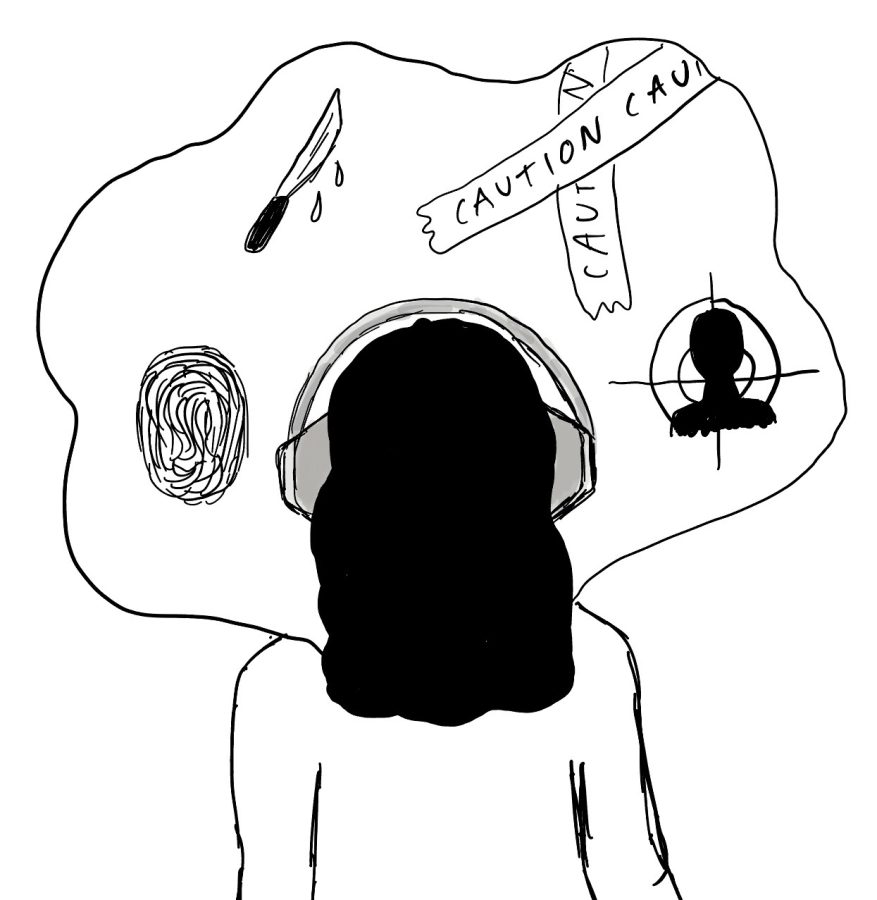“Weird psychological serial killer stuff”: Why does everyone love true crime?
True crime content has the world in a chokehold. According to a YouGov poll conducted in 2022, nearly half of all Americans have consumed some form of true crime content, with one out of three people admitting they watch true crime at least once a week. It may be hard to understand why people eagerly consume such gruesome and horrifying content. The stories shared are truly awful, ranging from kidnaps to sexual assaults to murder. But people cannot stop listening and watching. There is no singular reason for this mass obsession, but rather a multitude of factors including gender, race and human psychology.
“They’re interesting stories, just because they’re abnormal, right?” Leslie Schaffer, college counseling associate and true-crime fan, asked. Schaffer has been consuming true crime media since a young age. “I mean I must have been in third, fourth, fifth grade, something like that,” she said. She described what sparked her initial interest. “There were two kidnappings of girls my age when I was quite young,” Schaffer said. “One was Michaela Garecht and the other was Polly Klass and they were both local.” This felt personal to Schaffer. “It just hit really hard. Like that could happen to me or that could happen to my friends.” Since that point, Schaffer has been a dedicated true-crime fan, even attending an event called CrimeCon, a weekend-long educational event for true-crime fans, in 2019.
“[True-crime] is a lot of middle-aged men being the perpetrators and women and children being the victims,” Colby Daniels ‘24, fan of Criminal Minds and true-crime podcasts, said. In most cases, women are the focal point of true-crime stories.
Talia Becker ’25, another Criminal Minds fan, finds this reality challenging. “It can be hard to watch someone who is similar to you be targeted over and over again,” she said. Despite this, over 73% of true-crime viewers are female, according to the research paper “The Podcast Consumer 2019” by Boiling and Hull.
“I think the reason why true-crime is so popular for women is because we are wired as human beings to understand threats in our environment. And [these crimes] feel like a major threat,” said Schaffer. Psychologists at Oakland University found that women who are more fearful of rape tend to consume true-crime media with greater frequency because of their desire to learn preventative tactics against rape.
“I think there is a part of it about safety,” Becker said. “You see these horrible crimes and you see them being solved so you feel secure.”
While these stories help women feel more safe, men are also at risk for violence. Despite the focus on female stories, 80% of homicide victims are male, according to the Bureau of Justice report in 2019. Experts, mental health practitioners and women’s advocacy groups theorize that true-crime media focuses on women’s stories because women’s suffering sparks more outrage among the population. Some also believe that this female-focused lens is a result of the reality that sex crimes sell, and that those are usually centered around female victims.
However, true-crime media does not focus on women in general; it has a more narrow view of whose stories to tell. “Pretty young white ladies, white little girls even. That is where the interest is,” Schaffer said. “There are so many crimes [with women of color] out there that have the same story as a 22-year-old white girl, but nobody cares because she’s Hispanic or Black or not as pretty.”
This phenomenon is apparent in the case of Gabby Petito, a young white woman who went missing in Wyoming. Her story captured the public’s interest; her name was plastered all over the news, and internet sleuths took to trying to solve her case themselves. While the public rallied to support her, they were ignoring the hundreds of tragedies that occurred to non-white women in Wyoming before her incident. A 2022 University of Wyoming report showed that 710 Indigenous people had been reported missing in Wyoming within the last decade.
In an interview with The New Yorker, English Professor at Queensborough Community College and Scholar of true-crime Jean Murley said, “There’s something about the missing, young, beautiful white woman that has a lot of symbolic weight in America.” ‘Missing white woman syndrome’, as some people call it, has deep roots in American culture. “It’s an aberration,” Murley said, “and it becomes a container for things like the loss of innocence or the death of purity.”
Podcasts, Schaffer believes, provide a more neutral vehicle for telling true crime stories because one cannot see the victim or the perpetrator. “When something’s in your ears, it feels more immediate,” Schaffer said. “You don’t have that barrier of ‘this is what you look like.’ So I think in that way, podcasts are really useful for telling stories about all different races, genders, ages.”
Another reason listeners tune into these gruesome stories is to learn more about the perpetrator, not just the victim. “I like when they dive into the psychology,” Daniels said. “I like the weird psychological serial killer stuff.”
“For me, the fascination is not so much about what these broken people do as it is about why they do it. Deconstructing that mystery, getting to the very dark heart of their deeds, is what keeps [many] hopelessly captivated by true-crime stories,” Janice Holly Booth writes in her book “A Voice out of Nowhere: Inside the Mind of a Mass Murderer.”
Schaffer believes understanding why people act the way they do is the first step in preventing more crime. “I mean, the thing that makes [a podcast] stand out is when there’s something that we can learn from the situation,” Schaffer said. “I know it’s really popular to have young, beautiful victims, but whatever man, that’s not really what it’s about. It’s about how we can prevent these things from happening.”












